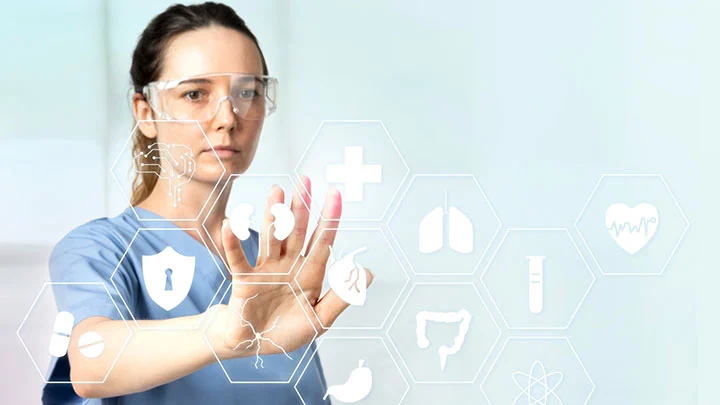Biometric Tech Advancements: From Security to Healthcare
In the ever-evolving global of technology, biometric generation stands at the vanguard of innovation, with packages starting from security to healthcare. This comprehensive article explores the latest advancements in the biometric era and its transformative effect on diverse industries. We’ll delve into the integration of biometric healthcare answers and the wider panorama of new tech opportunities, emphasizing the importance of “Biometric tech,” “Biometric healthcare,” “Tech development,” and “New tech.”
The Evolution of Biometric Tech
The biometric era, which identifies and authenticates individuals primarily based on precise physiological or behavioural traits, has come in an extended manner thinking about the truth of its inception. Initially, it observed its primary software program in security, wherein fingerprints and retinal scans have been used for entry to manipulate and identification verification. However, recent enhancements have improved its horizons, leading to its integration into various sectors.
Biometric Tech Advancements in Security
Facial Recognition: The facial reputation era has made significant strides in recent years. It’s now commonly used for getting admission to manipulate, airport protection, or even unlocking smartphones. The accuracy and velocity of facial popularity have progressed dramatically, making it a feasible alternative for secure authentication.
Iris Scanning: Iris scanning, which includes capturing the ideal styles in someone’s iris, is another place for improvement. It’s surprisingly accurate and is often applied in excessive-safety environments in which precision is important.
Behavioral Biometrics: Beyond physical developments, behavioural biometrics analyze how individuals interact with gadgets, which include typing patterns, mouse actions, and touchscreen gestures. This technology complements security using constantly authenticating customers based totally on their behavior.
Biometric Healthcare: A New Frontier
While the biometric era has long been associated with safety, its integration into healthcare is a groundbreaking development. “Biometric healthcare” refers to the use of biometrics to improve patient care, protection, and common healthcare strategies.
Patient Identification: Biometric authentication ensures accurate affected person identity, lowering scientific errors and enhancing patient safety. This is particularly crucial in environments wherein quick and correct identity is critical, which includes emergency rooms.
Electronic Health Records (EHRs): Biometric authentication complements the safety of digital health information. Healthcare professionals can get the right of access to affected humans’ information securely, making sure that sensitive facts stay extraordinary.
Medication Management: Biometrics may be used to confirm affected person identification earlier than administering medicines, decreasing the danger of medicine errors.
Access Control in Healthcare Facilities: Biometric access to manipulated structures facilitates the manipulation of who enters healthcare centres, making sure that the most effective prison employees have admission to important areas.
The Future of Biometric Healthcare
The integration of biometric generation into healthcare is just the beginning. As “Biometric healthcare” and “Tech advancement” preserve to benefit prominence, right here are some destiny possibilities:
Remote Patient Monitoring: Wearable biometric devices ought to continuously reveal patients’ crucial signs and symptoms and ship actual-time facts to healthcare carriers, making an allowance for early intervention and advanced control of persistent conditions.
Telemedicine: Biometric authentication will play a vital feature in verifying affected persons’ identities in the course of telemedicine appointments, ensuring the protection and privacy of online scientific consultations.
Biometric Sensors: Innovative biometric sensors can be embedded in clinical devices and gadgets, providing actual-time information for analysis and treatment.
Data Integration: Biometric information can be included with digital fitness information to offer a complete view of an affected man or woman’s health, permitting extra personalized treatment plans.

New Tech Horizons
Beyond healthcare and protection, biometric generation is paving the way for a range of recent tech possibilities:
Payment Authentication: Biometric authentication is turning into an extra standard in cellular charge structures. Fingerprint and facial recognition are more and more used for steady and convenient transactions.
Smart Homes: Biometrics can enhance the security of smart homes, allowing residents to unlock doorways, access devices, and manipulate structures using their biometric records.
Travel and Immigration: Airports are adopting biometric technology to expedite passenger processing. Facial recognition, especially, is streamlining the journey revel in.
Financial Services: Banks and monetary institutions are the usages of biometrics for secure client authentication, lowering the risk of fraud.
Education: Biometric authentication can decorate the safety of online getting-to-know systems, ensuring that students’ identities are tested during digital lessons and checks.
Automotive Industry: Biometrics may be covered in cars for motive force authentication, improving safety and personalizing the driving amusement.
Retail and Customer Experience: Retailers are exploring biometric solutions to beautify consumer studies, from personalized purchasing pointers to stable charge procedures.
Government Services: Government companies are implementing biometrics for consistent identity and authentication, improving the shipping of offerings to citizens.
Environmental Impact
It’s important not to forget the environmental effects of the biometric era. As the ones systems become greater widespread, there’s a developing need for energy-green hardware and responsible manufacturing strategies to lessen their carbon footprint. Biometric sensors, which encompass fingerprint scanners and facial recognition cameras, are an increasing number of protected devices like smartphones and laptops. Manufacturers are actively working to make the additives extra energy-inexperienced and sustainable.
Moreover, biometric information centres, wherein widespread amounts of data are saved and processed, are energy-intensive operations. To cope with this, some companies are investing in renewable electricity sources to strengthen their statistics centres, lowering the environmental impact.
Challenges and Ethical Considerations
As biometric technology advances, it additionally will increase ethical and privacy worries. The collection and storage of biometric records have to be performed securely and with strict privacy protections inside the vicinity. There is a need for clean hints and standards to govern the use of biometrics to defend human rights. Issues inclusive of consent, information ownership, and statistics breaches want to be addressed comprehensively.
Additionally, there’s the project to sure inclusivity and accessibility. Biometric systems have to be designed to house people with disabilities and various demographics. Ensuring that the generation is fair and unbiased is an essential moral consideration.
Conclusion
In the quit, biometric technology has transcended its preliminary characteristic in safety and is making notable inroads into healthcare and various other sectors. As “Biometric tech,” “Biometric healthcare,” “Tech development,” and “New tech” hold to shape the landscape of innovation, it is obvious that biometrics is a transformative stress that is reshaping the manner we technique safety, healthcare, and the wider international of the era.
As it continues to conform, we can assume even extra modern applications and possibilities on the horizon, revolutionizing the way we live, work, and engage with generation. Destiny is brimming with possibilities, and the biometric era is at the vanguard of this exciting journey into the virtual age, ushering in a new era of safety, healthcare, and technological development.
With every passing day, biometrics maintains breaking new floors, contributing to a greater stable, extra green, and extra personalized international of era-driven answers. However, it’s vital to address the environmental impact of that generation and the ethical troubles it increases. Responsible improvement, regulation, and a commitment to inclusivity and privacy are critical to harnessing the entire functionality of biometric technology in a manner that benefits society as a whole.


